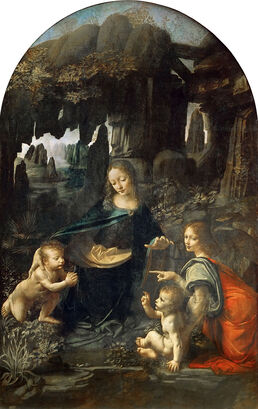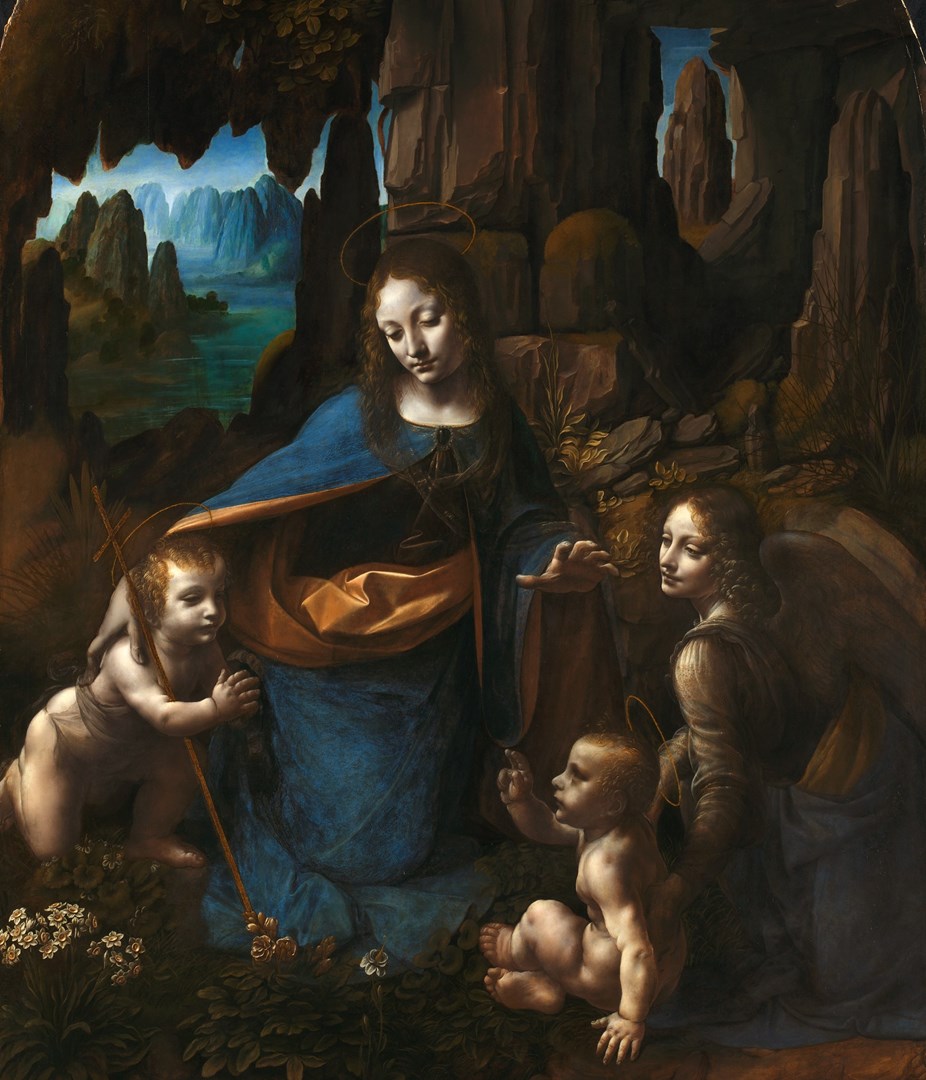|
The Virgin of the Rocks, sometimes known as Madonna of the Rocks, is the title of two paintings by Leonardo da Vinci. They both depict the same scene: the Madonna and Child Jesus with the infant John the Baptist and an angel in a rocky setting; however, there are a few significant differences, for example, the direction of the angel’s gaze. The original version, or at least the version considered to be the eldest, hangs in the Louvre in Paris, the other, hangs in the National Gallery and was the subject of the Leonardo exhibition. Leonardo was commissioned to paint The Virgin of the Rocks shortly after his move to Milan in the early 1480s. Having established his painting career in Florence, Leonardo had moved to search for new opportunities, which he found at the church of S. Francesco Grande. On 25th April 1483, Prior Bartolomeo Scoreline contracted Leonardo to produce painted panels for the new altarpiece in the Chapel of the Immaculate Conception that was attached to the church. Leonardo was contracted as the “master” of the project with brothers Ambrogio and Evangelista de Predis as his assistants. The artists were instructed on the colours and subject of the paintings. The central panel was to be of the Virgin Mary and Christ child with two prophets, perhaps David and Isaiah, surrounded by angels. Another panel was to show the Virgin Mary with God the panels to the side of the main painting were to contain angelic musicians. The job was to be completed by 8th December 1483, the Feast Day of the Immaculate Conception. As can be seen when looking at both versions of the painting, Leonardo did not stick to the instructions. Only one angel is present in the scene and there are no prophets except for the child John the Baptist. The church was not happy with the work Leonardo had produced by the completion deadline, therefore, he continued to work on it for a further five years until they were satisfied. Unfortunately, there was a dispute over payment so Leonardo, whether from spite or the need for money, sold the painting, which has eventually found itself in the Louvre. Leonardo was allowed to begin a second version, which was installed in the chapel in 1508. The subject of the two paintings, which was not what the church had originally requested, is the adoration of the Christ child by the infant John the Baptist. Although it depicts Biblical characters, the scene is not an event that features in the Bible. The Gospel of Matthew reports that Joseph, Mary’s husband, was warned by an angel in a dream about King Herod the Great who had ordered that “all the male children in Bethlehem and in all that region who were two years old or under” were to be killed. (Matthew 2:16 ESV) Therefore, Joseph fled to Egypt with his wife and Jesus. Several non-Biblical stories explain the flight to Egypt in more detail. One such story claims John the Baptist, Jesus’ cousin, was also staying with his family in Bethlehem where the Massacre of the Innocents was about to take place. Whilst the Holy Family made their way to Egypt after the angel’s warning, John the Baptist was escorted there by the Archangel Uriel, where he met his aunt and cousin on the road. It is this scene that Leonardo painted, therefore, it is assumed the angel he depicted is Uriel. Similar stories, however, claim the angel was Gabriel. It is not certain whose idea it was to deviate from the original contract but Leonardo had just come from Florence, whose patron saint was John the Baptist. Many religious artworks produced in Renaissance Florence involved the Christ child with John the Baptist, therefore, it may have only been natural for Leonardo to include the future preacher in his painting. Read the rest of the article here This blog post was published with the permission of the author, Hazel Stainer. www.hazelstainer.wordpress.com
0 Comments
Your comment will be posted after it is approved.
Leave a Reply. |
©Copyright
We are happy for you to use any material found here, however, please acknowledge the source: www.gantshillurc.co.uk AuthorRev'd Martin Wheadon Archives
June 2024
Categories
All
|


 RSS Feed
RSS Feed